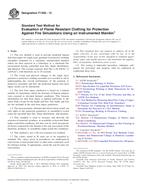Potrebujeme váš súhlas na využitie jednotlivých dát, aby sa vám okrem iného mohli ukazovať informácie týkajúce sa vašich záujmov. Súhlas udelíte kliknutím na tlačidlo „OK“.
ASTM F1930-13
Standard Test Method for Evaluation of Flame Resistant Clothing for Protection Against Fire Simulations Using an Instrumented Manikin
Automaticky preložený názov:
Štandardná skúšobná metóda pre hodnotenie nehorľavé oblečenie pre ochranu proti požiaru simulácia pomocou Instrumented figurína
NORMA vydaná dňa 1.2.2013
Informácie o norme:
Označenie normy: ASTM F1930-13
Poznámka: NEPLATNÁ
Dátum vydania normy: 1.2.2013
Kód tovaru: NS-52125
Počet strán: 17
Približná hmotnosť: 51 g (0.11 libier)
Krajina: Americká technická norma
Kategória: Technické normy ASTM
Anotácia textu normy ASTM F1930-13 :
Keywords:
fire, flash, flame testing, flammability, textile, manikin, instrumented flammability testing, protective clothing, thermal testing, ICS Number Code 13.340.10 (Protective clothing)
Doplňujúce informácie
| Significance and Use | ||||||||||||||||||||||||||||||||||||
|
5.1 Use this test method to measure the thermal protection provided by different materials, garments, clothing ensembles, and systems to a specified fire exposure (see 5.1.1 This test method does not simulate high radiant exposures, for example, those found in electric arc flash exposures, some types of fire exposures where liquid or solid fuels are involved, nor exposure to nuclear explosions. 5.2 This test method provides a measurement of garment and clothing ensemble performance on a stationary upright manikin of specified dimensions. This test method is used to provide predicted skin burn injury for a specific garment or protective clothing ensemble when exposed to a laboratory simulation of a fire. It does not establish a pass/fail for material performance. 5.2.1 This test method is not intended to be a quality assurance test. The results do not constitute a material’s performance specification. 5.2.2 The effects of body position and movement are not addressed in this test method. 5.3 The measurement of the thermal protection provided by clothing is complex and dependent on the apparatus and techniques used. It is not practical in a test method of this scope to establish details sufficient to cover all contingencies. Departures from the instructions in this test method have the potential to lead to significantly different test results. Technical knowledge concerning the theory of heat transfer and testing practices is needed to evaluate if, and which departures from the instructions given in this test method are significant. Standardization of the test method reduces, but does not eliminate, the need for such technical knowledge. Report any departures along with the results. |
||||||||||||||||||||||||||||||||||||
| 1. Scope | ||||||||||||||||||||||||||||||||||||
|
1.1 This test method is used to provide predicted human skin burn injury for single layer garments or protective clothing ensembles mounted on a stationary instrumented manikin which are then exposed in a laboratory to a simulated fire environment having controlled heat flux, flame distribution, and duration. The average exposure heat flux is 84 kW/m2 (2 cal/s•cm2), with durations up to 20 seconds. 1.2 The visual and physical changes to the single layer garment or protective clothing ensemble are recorded to aid in understanding the overall performance of the garment or protective ensemble and how the predicted human skin burn injury results can be interpreted. 1.3 The skin burn injury prediction is based on a limited number of experiments where the forearms of human subjects were exposed to elevated thermal conditions. This forearm information for skin burn injury is applied uniformly to the entire body except for the hands and feet. The hands and feet are not included in the skin burn injury prediction. 1.4 The measurements obtained and observations noted can only apply to the particular garment(s) or ensemble(s) tested using the specified heat flux, flame distribution, and duration. 1.5 This standard is used to measure and describe the response of materials, products, or assemblies to heat and flame under controlled conditions, but does not by itself incorporate all factors required for fire-hazard or fire risk assessment of the materials, products, or assemblies under actual fire conditions. 1.6 This method is not a fire-test-response test method. 1.7 The values stated in SI units are to be regarded as standard. The values given in parentheses are mathematical conversions to inch-pound units or other units commonly used for thermal testing. If appropriate, round the non-SI units for convenience. 1.8 This standard does not purport to address all of the safety concerns, if any, associated with its use. It is the responsibility of the user of this standard to establish appropriate safety and health practices and determine the applicability of regulatory limitations prior to use. 1.9 Fire testing is inherently hazardous. Adequate safeguards for personnel and property shall be employed in conducting these tests. |
||||||||||||||||||||||||||||||||||||
| 2. Referenced Documents | ||||||||||||||||||||||||||||||||||||
|
Odporúčame:
Aktualizácia technických noriem
Chcete mať istotu, že používate len platné technické normy?
Ponúkame Vám riešenie, ktoré Vám zaistí mesačný prehľad o aktuálnosti noriem, ktoré používate.
Chcete vedieť viac informácií ? Pozrite sa na túto stránku.




 Cookies
Cookies
